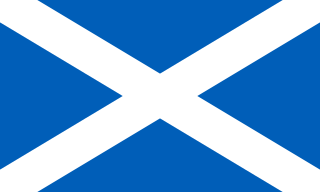 W
WThe culture of Scotland refers to the patterns of human activity and symbolism associated with Scotland and the Scottish people. Some elements of Scottish culture, such as its separate national church, are protected in law, as agreed in the Treaty of Union and other instruments. The Scottish flag is blue with a white saltire, and represents the cross of Saint Andrew.
 W
WAberdeen International Youth Festival was a festival of performing arts and one of Scotland's major international cultural events, which ran from 1981 to 2017.
 W
WSaint Andrew's Day, also called the Feast of Saint Andrew or Andermas, is the feast day of Andrew the Apostle. It is celebrated on 30 November. Saint Andrew's Day is Scotland's official national day. It has been a national holiday in Romania since 2015. Saint Andrew is the disciple in the New Testament who introduced his brother, the Apostle Peter, to Jesus as the Messiah. He is the patron saint of Cyprus, Scotland, Greece, Romania, Russia, Ukraine, the Ecumenical Patriarchate of Constantinople, San Andres Island (Colombia), Saint Andrew (Barbados) and Tenerife (Spain).
 W
WAn argyle pattern is made of diamonds or lozenges. The word is sometimes used to refer to an individual diamond in the design, but more commonly refers to the overall pattern. Most argyle contains layers of overlapping motifs, adding a sense of three-dimensionality, movement, and texture. Typically, there is an overlay of intercrossing diagonal lines on solid diamonds.
 W
WThe Association for Scottish Literary Studies (ASLS) is a Scottish educational charity, founded in 1970 to promote and support the teaching, study and writing of Scottish literature. Its founding members included the Scottish literary scholar Matthew McDiarmid (1914–1996). Originally based at the University of Aberdeen, it moved to its current home within the University of Glasgow in 1996. In November 2015, ASLS was allocated £40,000 by the Scottish Government to support its work providing teacher training and classroom resources for schools.
 W
WBank holidays in Scotland are determined under the Banking and Financial Dealings Act 1971 and the St Andrew's Day Bank Holiday (Scotland) Act 2007. Unlike the rest of the United Kingdom, most bank holidays are not recognised as statutory public holidays in Scotland, as most public holidays are determined by local authorities across Scotland. Some of these may be taken in lieu of statutory holidays, while others may be additional holidays, although many companies, including Royal Mail, do not follow all the holidays listed below; and many swap between English and local holidays. Many large shops and supermarkets continue to operate normally during public holidays, especially since there are no restrictions such as Sunday trading rules in Scotland.
 W
WBeltane is the Gaelic May Day festival. Most commonly it is held on 1 May, or about halfway between the spring equinox and summer solstice. Historically, it was widely observed throughout Ireland, Scotland, and the Isle of Man. In Irish the name for the festival day is Lá Bealtaine, in Scottish Gaelic Latha Bealltainn and in Manx Gaelic Laa Boaltinn/Boaldyn. It is one of the four Gaelic seasonal festivals—along with Samhain, Imbolc and Lughnasadh—and is similar to the Welsh Calan Mai.
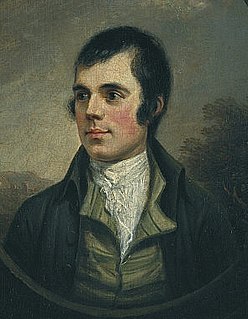 W
WBurns Clubs exist throughout the world to encourage and cherish the memory of Robert Burns, to foster a love of his writings and generally to encourage an interest in the Scots Language and Literature. An emphasis on encouraging the young to take an interest in Burns is found in most clubs through poetry, singing and other competitions. Once mainly existing as 'male only' clubs in the mould of the Tarbolton 'Batchelor's Club' most now welcome women as fellow members. Ladies Burns Clubs also exist such as the 'Irvine Lasses' that was established in 1975; it has appointed several male 'Honorary Lasses'.
 W
WA Burns supper is a celebration of the life and poetry of the poet Robert Burns, the author of many a Scots poem. The suppers are normally held on or near the poet's birthday, 25 January, known as Burns Night. However, in principle, celebrations may be held at any other time of the year. Burns suppers are held all around the world.
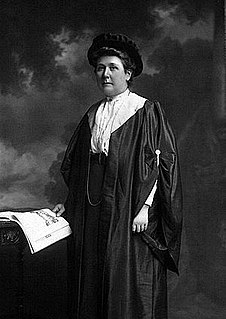 W
WGrace Ross Cadell was in the first group of women to study medicine in Scotland and qualify. She was, with Elsie Inglis, one of the initial entrants to the Edinburgh School of Medicine for Women, set up by Sophia Jex-Blake in 1886. Her determination and character were demonstrated by her standing up to Jex-Blake over a disciplinary matter, being dismissed from the school and subsequently successfully suing Jex-Blake and her school. Her career as a Scottish pioneer physician, surgeon was devoted mainly to the care of women and children. She became an active suffragette as was well known for public acts of defiance in the cause of women's suffrage. She was prominent in providing medical care and refuge for her fellow suffragettes, some of whom were released into her care directly from episodes of force feeding in prison. Her home became well known as a sanctuary for suffragettes.
 W
WCaledonia was the Latin name used by the Roman Empire to refer to the part of Great Britain that lies north of the River Forth, which includes most of the land area of Scotland. Today, it is used as a romantic or poetic name for all of Scotland. During the Roman Empire's occupation of Scotland, the area they called Caledonia was physically separated from the rest of the island by the Antonine Wall. The Romans several times invaded and occupied it, but unlike the rest of the island, it remained outside the administration of Roman Britain.
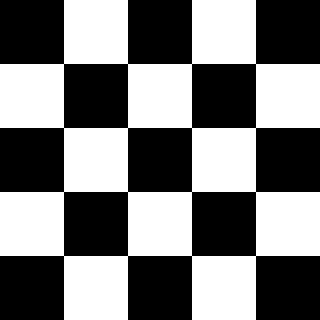 W
WCheck is a pattern of modified stripes consisting of crossed horizontal and vertical lines which form squares. The pattern typically contains two colours where a single checker is surrounded on all four sides by a checker of a different colour.
 W
WA common riding is an equestrian tradition mainly in the Scottish Borders in Scotland. Typically male riders ride out of the town and along its borders to commemorate the practice from 13th and 15th centuries where there were frequent raids on the Anglo-Scottish border known as the Border Reivers and also to commemorate the Scottish defeat at the Battle of Flodden. Today, the common ridings, rideouts, or riding of the marches continue to be annual events celebrated in the summer in the Borders of Scotland. Each town may have many rideouts over their festival week, usually having one on festival day. Some towns re-enact historic 'common ridings' – although many others have well-established 'festival rides' that are cemented within their town's history. The common riding towns are: Berwick-upon-Tweed, Hawick, Selkirk, Langholm, Jedburgh, Coldstream, West Linton, Lanark, Lauder, Edinburgh, Melrose, Musselburgh, Galashiels, Duns, and Peebles.
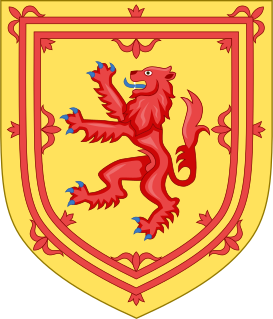 W
WThe Communities Directorates are a group of civil service Directorates in the Scottish Government. The individual Directorates within the overarching Communities Directorates report to the Director-General, Paul Johnston.
 W
WA currach is a type of Irish boat with a wooden frame, over which animal skins or hides were once stretched, though now canvas is more usual. It is sometimes anglicised as "curragh".
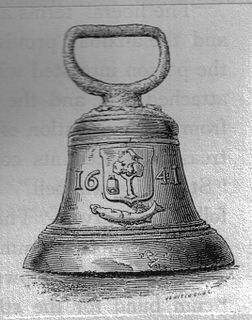 W
WA dead bell or deid bell (Scots), also a 'death', 'mort', 'lych', 'passing bell' or 'skellet bell' was a form of hand bell used in Scotland and northern England in conjunction with deaths and funerals up until the 19th century.
 W
WA Drunk Man Looks at the Thistle is a long poem by Hugh MacDiarmid written in Scots and published in 1926. It is composed as a form of monologue with influences from stream of consciousness genres of writing. A poem of extremes, it ranges between comic and serious modes and examines a wide range of cultural, sexual, political, scientific, existential, metaphysical and cosmic themes, ultimately unified through one consistent central thread, the poet's affectively charged contemplation, looking askance at the condition of Scotland. It also includes extended and complex responses to figures from European and Russian literature, in particular Dostoevsky and Nietzsche, as well as referencing topical events and personalities of the mid-1920s such as Isadora Duncan or the UK General Strike of 1926. It is one of the major modernist literary works of the 20th century.
 W
WThe Swedish Runestone, designated U 1173 in the Rundata catalogue, is an 11th-century Swedish Viking Age runestone which was located in Princes Street Gardens, Edinburgh, below Edinburgh Castle Esplanade, within a fenced enclosure adjacent to Ramsay Garden. Due to security concerns it was removed from its location in December 2017 and has been moved in 2020 to 50 George Square, Edinburgh just outside University of Edinburgh's Department of Scandinavian Studies.
 W
WThe Gàidhealtachd usually refers to the Highlands and Islands of Scotland and especially the Scottish Gaelic-speaking culture of the area. The corresponding Irish word Gaeltacht refers strictly to Irish-speaking areas.
 W
WThe Gathering 2009 was a two-day weekend event, celebrating Scottish culture, held between 25 and 26 July 2009, as part of Homecoming 2009. The event was held at Holyrood Park, Scotland, and attracted around 47,000 people from all over the world. Over 125 Scottish clans were represented in what was described as the largest Highland Games in Scotland's history. A clan convention also took place, also the largest recorded meeting of chiefs.
 W
WThe Gododdin were a P-Celtic-speaking Brittonic people of north-eastern Britannia, the area known as the Hen Ogledd or Old North, in the sub-Roman period. Descendants of the Votadini, they are best known as the subject of the 6th-century Welsh poem Y Gododdin, which memorialises the Battle of Catraeth and is attributed to Aneirin.
 W
WGude Cause was the name of a feminist project, based at the Peace and Justice Centre in Edinburgh, Scotland, which inspired over 60 events and projects throughout Scotland between 2007 and 2009.
 W
WHalloween or Hallowe'en, also known as Allhalloween, All Hallows' Eve, or All Saints' Eve, is a celebration observed in many countries on 31 October, the eve of the Western Christian feast of All Hallows' Day. It begins the observance of Allhallowtide, the time in the liturgical year dedicated to remembering the dead, including saints (hallows), martyrs, and all the departed.
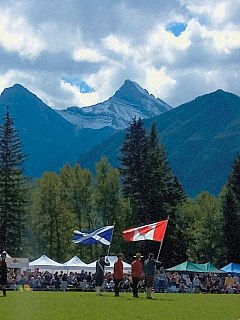 W
WHighland games are events held in spring and summer in Scotland and other countries with a large Scottish diaspora, as a way of celebrating Scottish and Celtic culture, especially that of the Scottish Highlands. Certain aspects of the games are so well known as to have become emblematic of Scotland, such as the bagpipes, the kilt, and the heavy events, especially the caber toss. While centred on competitions in piping and drumming, dancing, and Scottish heavy athletics, the games also include entertainment and exhibits related to other aspects of Scottish and Gaelic cultures.
 W
WThe Honours of Scotland, informally known as the Scottish Crown Jewels, are regalia that were worn by Scottish kings and queens at their coronations. Kept in Edinburgh Castle, they date from the 15th and 16th centuries, and are the oldest surviving set of crown jewels in the British Isles.
 W
W"Jock Tamson's bairns" is a Lowland Scots dialect version of "Jack (John) Thomson's children" but both Jock and Tamson in this context take on the connotation of Everyman. The Dictionary of the Scots Language gives the following definitions:Jock: (1) A generic term for a man, a male person. (34) Jock Tamson's bairns: the human race, common humanity; also, with less universal force, a group of people united by a common sentiment, interest or purpose. Tamson: a Scottish form of the surname Thomson. In phrases Tamson stands for the ordinary representative man in the street: Jock Tamson's bairns, common humanity.
 W
WEvery June the town of Lanark in Scotland holds its Lanimer Week celebrations. The festivities reach a high point on the Thursday of Lanimer week, when the town's schoolchildren parade in fancy dress with decorated vehicles, pipe bands, and a Lanimer Queen and her Court, who have been elected from local schools on their gala day.
 W
WThe Land Reform (Scotland) Act 2003 is an Act of the Scottish Parliament which establishes statutory public rights of access to land and makes provisions under which bodies representing rural and crofting communities may buy land.
 W
WThe Land Reform (Scotland) Act 2016 is an Act of the Scottish Parliament which continues the process of land reform in Scotland following the Community Empowerment (Scotland) Act 2015. It is notable for granting Scottish ministers the power to force the sale of private land to community bodies to further sustainable development in the absence of a willing seller.
 W
WA Luckenbooth brooch is a Scottish heart-shaped brooch. These brooches often have a crown above one heart, or two intertwined hearts. They are typically made of silver and may be engraved or set with stones.
 W
WLughnasadh or Lughnasa is a Gaelic festival marking the beginning of the harvest season. Historically, it was widely observed throughout Ireland, Scotland and the Isle of Man. In Modern Irish it is called Lúnasa, in Scottish Gaelic: Lùnastal, and in Manx: Luanistyn. Traditionally it is held on 1 August, or about halfway between the summer solstice and autumn equinox. In recent centuries some of the celebrations have been shifted to the Sunday nearest this date.
 W
WA manse is a clergy house inhabited by, or formerly inhabited by, a minister, usually used in the context of Presbyterian, Methodist, Baptist and other Christian traditions.
 W
WScottish media has a long and distinct history. Scotland has a wide range of different types and quality of media.
 W
WAs Scotland is part of the United Kingdom, the British national anthem God Save The Queen is used in Scotland for example for royal occasions, or when Scottish athletes participate at the Olympics. However, in other situations, other songs are used as de facto Scottish anthems, most notably "Flower of Scotland" and "Scotland the Brave". There have been calls for Scotland to have its own official national anthem.
 W
WScottish national identity is a term referring to the sense of national identity, as embodied in the shared and characteristic culture, languages and traditions, of the Scottish people.
 W
WThe National Trust for Scotland for Places of Historic Interest or Natural Beauty, commonly known as the National Trust for Scotland, is a Scottish conservation organisation. It is the largest membership organisation in Scotland and describes itself as "the conservation charity that protects and promotes Scotland's natural and cultural heritage for present and future generations to enjoy".
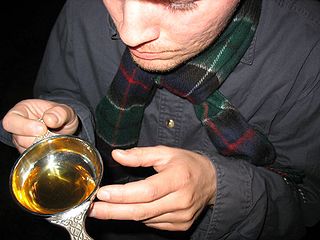 W
WA quaich, archaically quaigh or quoich, is a special kind of shallow two-handled drinking cup or bowl of a type traditional in Scotland. It derives from the Scottish Gaelic cuach, meaning a cup.
 W
WThe Robert Burns World Federation is a literary society based in Kilmarnock, Ayrshire, Scotland, aimed at educating the public about the life, poetry and works of the poet Robert Burns. It is a Scottish Charity and a company limited by Guarantee. The Federation links existing Burns Clubs and similar groups, giving a unique number to affiliated Clubs, which is then used by them in their promotion and identification. Their ongoing intent is to provide a way for clubs to link together and enjoy the mutual benefit of association, communication and shared mission. It was founded in 1885
 W
WThe Royal National Mòd is a peripatetic festival held annually in Scotland. It is the largest of several major Scottish Mòds, and focuses on Scottish Gaelic literature, song, arts and culture. It is often referred to simply as the Mòd.
 W
WThe Scottish Arts Council was a Scottish public body responsible for the funding, development and promotion of the arts in Scotland. The Council primarily distributed funding from the Scottish Government as well as National Lottery funds received via the Department for Culture, Media and Sport.
 W
WThe Scottish State Coach is an enclosed, four-horse-drawn carriage used by the British Royal Family.
 W
WThe Sword Dance is one of the best known of all Highland dances, an ancient dance of war. Performance of sword dances in the folklore of Scotland is recorded from as early as the 15th century.
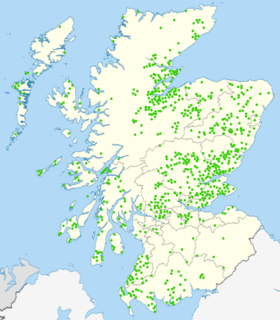 W
WScottish toponymy derives from the languages of Scotland. The toponymy varies in each region, reflecting the linguistic history of each part of the country.
 W
WSheep shearing is the process by which the woollen fleece of a sheep is cut off. The person who removes the sheep's wool is called a shearer. Typically each adult sheep is shorn once each year. The annual shearing most often occurs in a shearing shed, a facility especially designed to process often hundreds and sometimes more than 3,000 sheep per day.
 W
WThe St Andrew's Day Bank Holiday (Scotland) Act 2007 is an Act of the Scottish Parliament that officially designates St. Andrew's Day to be a bank holiday in Scotland.
 W
WA stirrup cup is a "parting cup" given to guests, especially when they are leaving and have their feet in the stirrups. It is also the traditional drink served at the meet, prior to a traditional foxhunt. The term can describe the cup that such a drink is served in.
 W
WThe Tain & District Museum, is located in Tain, Ross-shire, Scotland. It is volunteer-run and is open April to October part of the Tain Through Time visitor centre. The museum was established in 1966 and has a collection of silver made in the local area.
 W
WThe Tenements (Scotland) Act 2004 is an Act of the Scottish Parliament which is the main source of the law of the tenement, which regulates tenement flats.
 W
WThe Term and Quarter Days (Scotland) Act 1990 is an Act of the Parliament of the United Kingdom which defined the dates of the Scottish Term and Quarter Days. These are customary divisions of the legal year when contracts traditionally begin and end and payments are due. It received Royal Assent on 13 July 1990 and immediate commencement, with the dates of the days changing twelve months later. The changes arose from a Scottish Law Commission Report on the Scottish Term and Quarter Days.
 W
W"True Scotsman" is a humorous term used in Scotland for a man wearing a kilt without undergarments. Though the tradition originated in the military, it has entered Scottish lore as a rite, an expression of light-hearted curiosity about the custom, and even as a subversive gesture.
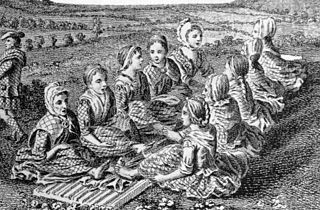 W
WWaulking songs are Scottish folk songs, traditionally sung in the Gaelic language by women while fulling (waulking) cloth. This practice involved a group of women rhythmically beating newly woven tweed or tartan cloth against a table or similar surface to lightly felt it and shrink it to better repel water. Simple, beat-driven songs were used to accompany the work.
 W
WWe Are Northern Lights is a 2013 Scottish documentary film about the Scottish people, which was screened around Scotland. According to the BBC it was created using footage taken by over 100 members of the Scottish public during 2012. It is described as Scotland's first ever crowd sourced film project. It was shown at the Glasgow Film Festival in 2013 before being distributed to 5 Scottish Cineworld cinemas. It was also chosen as the opening film for the 2013 Glasgow Southside Film Festival.
 W
WThe West Port Book Festival was a book festival which was held in Edinburgh from 2008 to 2012. Initially it took place in August during the busy Edinburgh Festival season, but later it was held at different times in the year. The idea for the festival came from Hannah Adcock who was also the driving force behind it.
 W
WA wynd is typically a narrow lane between houses. The name is frequently encountered in towns and villages in Scotland and Northern England. The word derives from Old Norse venda, implying a turning off a main street, without implying that it is curved. In fact, most wynds are straight. In many places wynds link streets at different heights and thus are mostly thought of as being ways up or down hills.